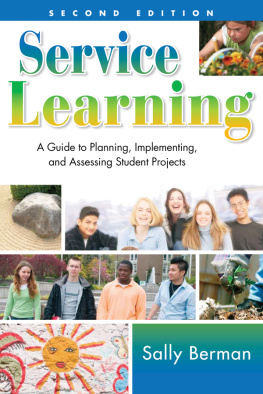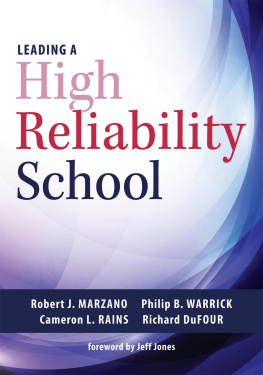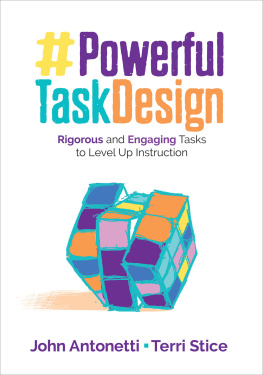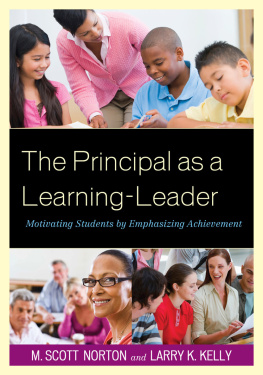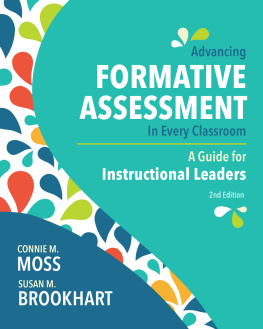Second Edition
Performance-Based Learning
To my sister
Mary Anne Snyder,
a model performance learner
Second Edition
Performance-Based Learning
Aligning Experiential Tasks and Assessment to Increase Learning
Sally Berman
Second Edition of
Performance Based Learning for the Multiple Intelligences Classroom

Copyright 2008 by Corwin Press
All rights reserved. When forms and sample documents are included, their use is authorized only by educators, local school sites, and/or noncommercial or nonprofit entities that have purchased the book. Except for that usage, no part of this book may be reproduced or utilized in any form or by any means, electronic or mechanical, including photocopying, recording, or by any information storage and retrieval system, without permission in writing from the publisher.
For information:

| Corwin Press
A Sage Publications Company
2455 Teller Road
Thousand Oaks, California 91320
www.corwinpress.com Sage Publications Ltd.
1 Olivers Yard
55 City Road
London EC1Y 1SP
United Kingdom Sage Publications India Pvt. Ltd.
B 1/I 1 Mohan Cooperative
Industrial Area
Mathura Road, New Delhi 110 044
India Sage Publications Asia-Pacific Pte. Ltd.
33 Pekin Street #02-01
Far East Square
Singapore 048763 |
Printed in the United States of America.
Library of Congress Cataloging-in-Publication Data
Berman, Sally.
Performance-based learning: Aligning experiential tasks and assessment to increase learning/Sally Berman.2nd ed.
p. cm.
Includes bibliographical references and index.
ISBN 978-1-4129-5309-2 (cloth : alk. paper)
ISBN 978-1-4129-5310-8 (pbk. : alk. paper)
1. Competency based educationUnited States. I. Title.
LC1032.B46 2008
371.39dc22
2006102776
This book is printed on acid-free paper.
08 09 10 11 12 10 9 8 7 6 5 4 3 2 1
Acquisitions Editor: | Cathy Hernandez |
Editorial Assistant: | Megan Bedell |
Production Editor: | Sarah K. Quesenberry |
Copy Editor: | Cate Huisman |
Typesetter: | C&M Digitals (P) Ltd. |
Proofreader: | Gail Fay |
Indexer: | Molly Hall |
Cover Designer: | Lisa Riley |
Contents
Preface
F or the past several years, classroom teachers and assessment authorities have extolled the benefits of performance assessment. As students show what they know by doing a performance or task, teachers see more clearly what students have mastered and what learning has eluded them. Good teachers use the results of performance assessments to improve the learning experiences that students encounter in their classrooms. Caring teachers say, If we expect students to do a task or performance to demonstrate their learning, we need to make learning contextual. We want the learning experiences to align with the assessment techniques.
These teachers construct communities of active learners in their classrooms. They invite students to become partners by explaining the learning standards that students are expected to meet, giving students rubrics that describe developmental levels of performance, and showing students how to use the rubrics to evaluate the strengths of their present performances, decide how to improve those performances, and work toward that improvement. In these classrooms, students learn the life-long skill of kaizen, the use of continual self-assessment, adjustment, and stepwise improvement to achieve high-quality results.
Performance-based learning has roots in the ideas of John Dewey. With his strong belief in the educative nature of all experience, Dewey (1916) saw doing as a way of connecting information and ideas. The work of Csikszentmihalyi (1990) on flow, the experience of being so immersed in an engaging task that one is swept along in its current, provides more current thinking on the value of experiential learning.
In 1988, Dr. Marian Diamond said that experiential learning is the key to growing the axon-dendrite connections that brains use to process cognitive information. Her studies suggest that student involvement and interaction with materials in and out of the classroom build better brains for learning. Caine and Caine (1991) stated that the brain remembers best what it learns in context. Both sets of research point to performance learning as a tool for developing deeper understanding and for enhancing ability to apply knowledge of facts appropriately in a new situation (Gardner, 1991). More recently, Keller (2004) stated that maximizing student success in school involves increasing not only rigor, but also relevance. Performance-based learning is well suited to accomplishing this difficult assignment.
Performance learning is a curriculum model that produces deep, long-lasting learning and develops expertise in procedural skills, and it can be used successfully by teachers in all grade levels, kindergarten through college, with students from all socioeconomic groups and communities.
AS YOU READ THIS BOOK
The Chapters
First, notice that the focus of this book is not performance assessment. Each activity in details a learning experience that aligns with assessment. If the goal of the assessment is to have students show what they know, the goal of the activity is to experience the knowing.
Read the first chapter carefully. It contains the research base for this curriculum model, and it references the work done by many educational and brain physiology experts. The reference section at the end of the book lists these and other references. Readers are encouraged to obtain and read some of these resource materials to acquire useful tips and background information.
Browse through the rest of the chapters. Each chapter details a performance learning task that the teacher may choose to use as presented or may use as a model for developing performance learning applications of his or her own. Notice that each chapter uses the same basic outline that includes the performance, prompt, vision, standards, coaching context, presentation, and reflection.
Each chapter begins by addressing the student audience targeted by the task (The Audience) and includes a brief description of the performance learning task and reasons why the task fits the performance learning model (The Performance). The chapter goes on to describe how the teacher might present the task and to provide examples of excellent performance presentations to the students (The Prompt).
In each chapter, the section titled The Vision describes how the teacher and students can inspect examples of learning and presentation excellence. These examples of expert practices in learning and presenting will help students self-evaluate and improve the quality of their learning as they work their way through the performance task and the final presentation.
In The Standards, look at the task development chart. It contains the steps in the performance task, the curriculum standards that align with the task, and a description of the performance development levels from novice to expert. The Standards also contains the rubric for the performance learning task. This rubric can be used as a final assessment tool. Its more powerful use is for ongoing self-evaluation and performance improvement by students as they work toward the final presentation. Students who know the assessment standards, or criteria, and who have seen examples of excellent performances will demonstrate deeper understanding and more proficient learning.
Next page

